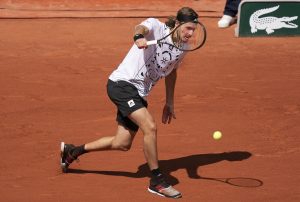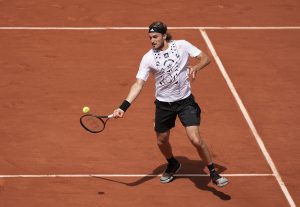During Ash Barty’s semifinal against Angelique Kerber the commentators waxed lyrical about Barty’s variety and smooth game. It is relatively rare for any player to receive so many compliments. In fact, the last time a player with a two-handed backhand received so many compliments about their game and movement was Martina Hingis. This was well over twenty years ago. The two hander is usually associated with a bludgeoning style. What makes Barty unique is she often takes one hand off the racket, relying on the slice rather than the driven topspin backhand.
It is fair to say Barty stands out in the women’s game. And the question has to be, why is this the case? The WTA Tour was once well-stocked players with a one-handed backhand, a shot often associated with elegance and smooth movement. Now players like Viktorija Golubic – a quarterfinalist this year at Wimbledon – are thin on the ground. Golubic has been on the tour a number of years, but she is also the first player with a one-handed backhand to make it so far at Wimbledon for many years.
There has been a total evolution of the backhand on the WTA tour. Before 1970, virtually every player used a one-hander. That all changed with the arrival of Chris Evert in the early 1970s. Evert along with Jimmy Connors completely changed the way the game is played, principally by using two hands on the backhand side. For a while Evert was an outlier, despite dominating the game for long periods. A mini-Chris Evert arrived in the late 1970s in the name of Tracy Austin from California. Austin won the US Open in 1979 and 1980, defeating Evert in the 1979 final. Austin was only 16 years old.
As the 1980s progressed and Evert continued to rival Martina Navratilova, the two-handed backhand was still an outlier on the tour. Steffi Graf came through in the late 1980s to usurp Navratilova from the number 1 position. However, the tide was finally starting to turn.
In my view there are three main reasons for this. The first is the switch to graphite racket. Players born in the early 1970s switched from wood to graphite rackets at an early age. By today’s standards, graphite rackets would be considered to be heavy. However, for juniors in the early 1980s they were much more manoeuvrable than wood or steel rackets. The open throat design also made it much easier to hit consistently.
The second reason was the number of hard courts which were springing up all over the United States, replacing first grass then green clay on the ATP and WTA circuit. The third reason is the rise of the Nick Bollettieri academy in Florida. Many of the top young came through the academy. From Andre Agassi, to Jim Courier, Mary Pierce and Monica Seles. The mantra being to hit as hard as possible, as early as possible. This formula for success spread to other tennis schools.
Things were changing not just in the United States. In 1989, Arantxa Sanchez Vicario from Spain exploded onto the scene winning the French Open age 17. Seles won the French Open a year later age 16 and completely dominated tennis until her terrible stabbing in 1993. This allowed Graf to re-establish her dominance but by now was challenged by a variety of two handers in finals. Mary Joe Fernandez in the 1993 French Open final, Sanchez Vicario in a number of finals between 1994 and 1996. By the late 1990s, most top players had two hands on the backhand. Martina Hingis dominated in the late 1990s. followed by Venus and Serena Williams plus Lindsay Davenport. In the year 2000, Elena Dementieva and Kim Clijsters appeared on the scene as promising teenagers.
Despite this upsurge, there were still a number of top one handers on the WTA tour. This included Conchita Martinez who won Wimbledon in 1994, Gabriela Sabatini, Jana Novotna, Natalie Tauziat and top 20 players such as Irina Spirlea. In 1999 Amelie Mauresmo announced her arrival by reaching the final of the Australian Open as a 19-year-old. And in the year 2000, Justine Henin made a big splash with her single hand backhand which had so much power and precision.
The stage was set for the 2000s, which proved to be the most exciting period in women’s tennis in the open era. Players took turns to dominate between 2000 and 2009. There were multiple slam winners and there was always something for the fans and media to talk about. Justine Henin and Amelie Mauresmo played a big part in this. They provided a great contrast in style to the likes of Venus, Serena, Davenport, Capriati and Sharapova. Henin and Mauresmo were able to hit stunning topspin backhands down the line and crosscourt. They were also adept at the use of the slice backhand, the backhand volley and the stop volley.
The last ever all serve volley final took place between Henin and Mauresmo in the 2006 Wimbledon championships. Mauresmo used the tactic throughout the entire match, whilst Henin was forced to use it from late in the second set to get Mauresmo off the net. I expected the success and aesthetically pleasing game of Henin and Mauresmo to usher in young players inspired to play a similar game. However, this never materialised.
Besides Roberta Vinci and Francesca Schiavone who were contemporaries of Henin and Mauresmo, the one hander dried up completely. Only Carla Suarez Navarro made the top 10 from the proceeding crop of players in the 2010s.
Today, there are virtually no players in the top 100 with a single hand backhand. In fact, the WTA did a compilation in April 2020 listing just 12 players in the entire rankings with a one-handed backhand, this did not make for pleasant reading. But how have we reached this stage and can it change?
In the 2000s, tennis evolved yet again. This time, hardcourts became slower and higher bouncing. This coincided with advancements in racket and string technology. Juniors were now learning to play with lighter titanium rackets than heavier graphite equivalent. This made volleying an almost superfluous pastime. In the 1990s, even though many top players were two handers, they won lots of big doubles titles, having learned the transition game as juniors.
Today, players are not learning how to volley properly with slice. Many juniors are hitting drive volleys instead, they don’t change grips to hit certain shots. There is absolutely no incentive for junior coaches to encourage their charges to take one hand off the racket and play as a one hander when they are physically able.
This has led to a baseline-oriented game where the volley is no longer such an important tool in the WTA player’s armoury. However, there is a distinct co-relation between the lack of volleying skills and the disappearance of the one hand backhand.
Ironically in men’s tennis, the one hand backhand is alive and well and survived through to the “next gen”. Stefanos Tsitsipas is the current highest ranked one hander at world #4, but there are three in the top 10 with Dominic Thiem and Roger Federer also using just one hand on the racket. Dennis Shapovalov who made the Wimbledon semifinal this year will soon be Top 10. Lorenzo Musetti at age 19 is an interesting prospect. Not to mention veterans like Stan Wawrinka, Grigor Dimitrov, Dan Evans and Richard Gasquet.
One thing links all of these players, they are all court players who can mix things up. This is something badly lacking in the WTA tour right now, even if the depth is strong.
What I want to see is attitudes change. We need coaches who are prepared to go against the tide and stick to their principles and develop players who can take one hand off the racket and develop the dashing one hand backhand. A shot that looks spectacular and can be extremely versatile as well. We need more coaches like Carlos Rodriguez who nurtured Justine Henin and persuaded a then 30-year-old Li Na to serve and volley.
If that can happen, then maybe at some point in the future there may be a revival of the one hand backhand in the women’s game.
Main photo:
Embed from Getty Images






